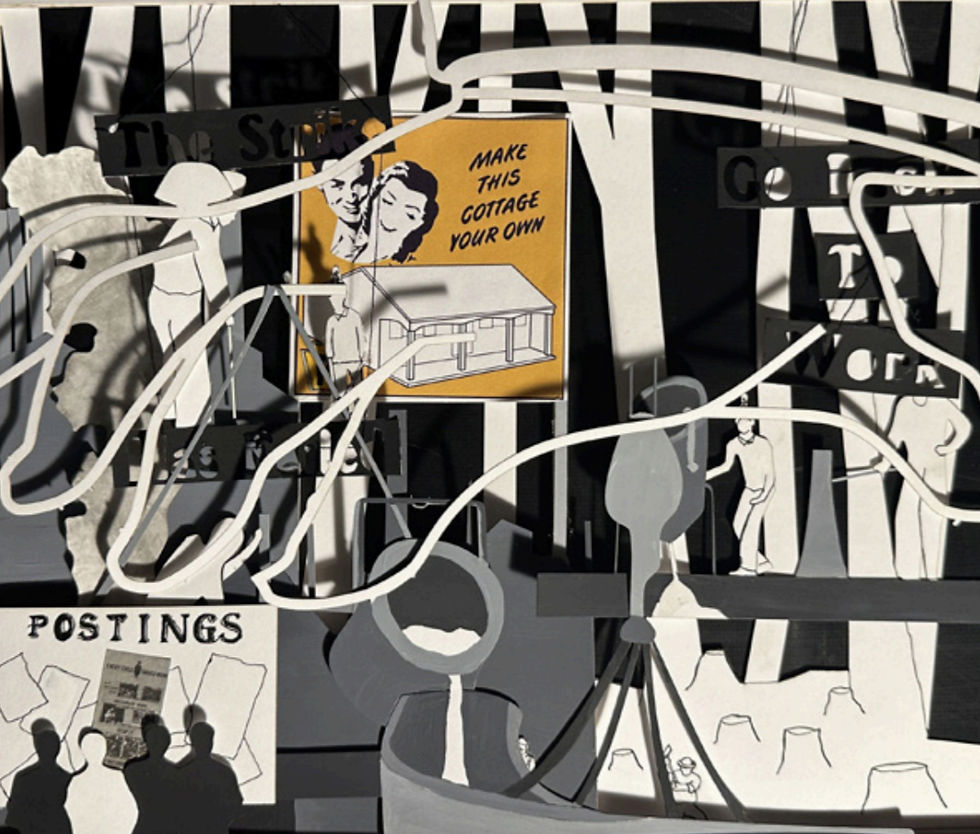
GOD FROM THE MACHINE
The intention of this project is to look at Pittsburgh through the technology of propaganda. Pittsburgh was and perhaps still is most widely known for the impact of its bustling steel industry. Oftentimes through propaganda in the form of advertisements and marketing the complexities of the steel industry are ignored. During the Industrial Revolution in Pittsburgh the rights of workers were severely undervalued resulting in increased work related accidents and child labor. This scene takes a look at a man through various stages of his life in the early 1900s as he increasingly became more a part of the Pittsburgh steel industry due to the influences of propaganda luring him into the workforce. The character then moves deeper and deeper into the steel industry overtime and in turn loses his humanity and autonomy, becoming lost in the machinery. Looking through the different apertures gives different perspectives. This is meant to symbolize the ability for propaganda to alter meaning and reality due to a lack of context. Within the full context of the peep show the viewer is able to discern a more accurate understanding of the industrial age. The framed panels act as a nod to the work of photographer Lewis Hine who brought attention to the realities of the working conditions in factories across the country during the Industrial Revolution through his photography.
Technology of Propaganda
Bulletin Board of Propaganda
This bulletin board tells a history of Pittsburgh through propaganda that defined each era. The board is organized into three main eras: the colonial era connected through red string, the industrial era connected through yellow string, and the modern era connected through green string. The use of a bulletin is referential to the bulletins used for postings found in factories. These bulletins allowed people to communicate ideas in a space that would be accessible to all workers. The board also builds off of the last project in that it dispels chronological organization in favor of inviting viewers to draw connections between language and messaging through time. The propaganda pieces can also all be flipped up or removed from the posting board to read the back descriptions that provide further contexts of the meaning and intention behind them.


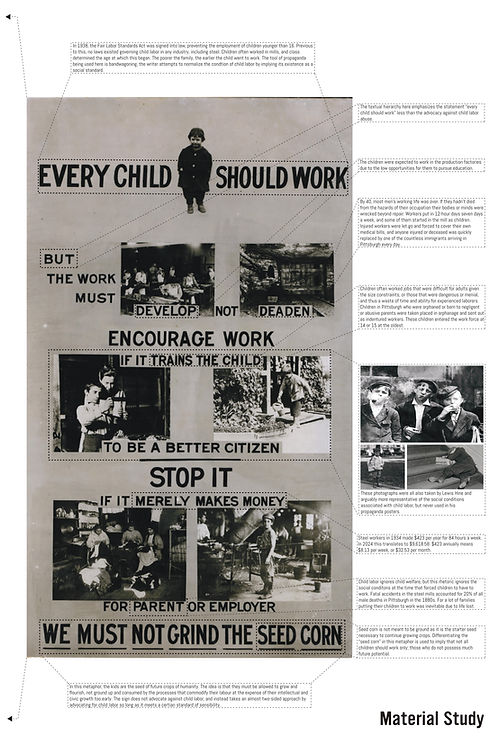
Through focusing on one artifact from the poster series to annotate the intention is to break down the uses of language and visual style that reflects the typology of propaganda as a whole as well as the social contexts at the time. This series alters famous propaganda images from the early to mid-1900s to now describe the visual techniques used in Lewis Hine’s propaganda posters to aid in the articulation and spread of his messaging.
Labor Rights Propaganda Map
This map is meant to represent the relationships between printing presses and labor rights groups in Pittsburgh. The map is done primarily in black and white as activists like Lewis Hine often kept printing in black and white to increase accessibility. The only bit of red used in the map is meant to be representative of annotations a person would make on top of such maps to make note of the important locations and connection routes. The drawings at the top represent the cruel irony of labor rights activism at the time as while groups like the NCLC intended to stop child labor it was often children working the at the presses that would print these anti-child labor postings. The border gears begin to enforce the idea of people being the tool of industry.

Industry Propaganda Map
This propaganda map tracks the growth of the steel industry in Pittsburgh and represents a propagandized view of the city. Notably the grass appears green and there is a large bag being spilled onto the city labeled as “Carnegie Millions for Public Good.” Additionally the advertisement on the bottom encourage labor in exhange for working towards commodities that signified one’s elvated social status at the time, like home ownership and car ownership. The border is adorned with bowler hats, as another reference to Andrew Carnegie’s signature bowler hat. The three stars are a reference to iconic American propaganda symbols like Uncle Sam that are depicted with three stars.


Typological Analysis
Application of Systems Catalogue
This booklet acts as a tutorial for producing propaganda through chronicling the process of producing Lewis Hine’s propaganda poster series. Each step in the process acts as its own propaganda poster through reflecting the style of propaganda previously studied.

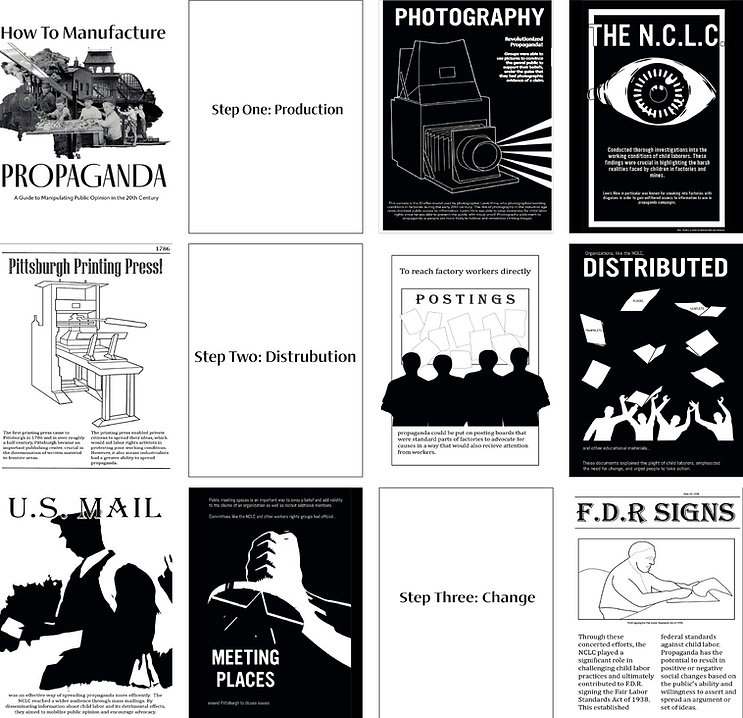
Curated for You
View Gallery
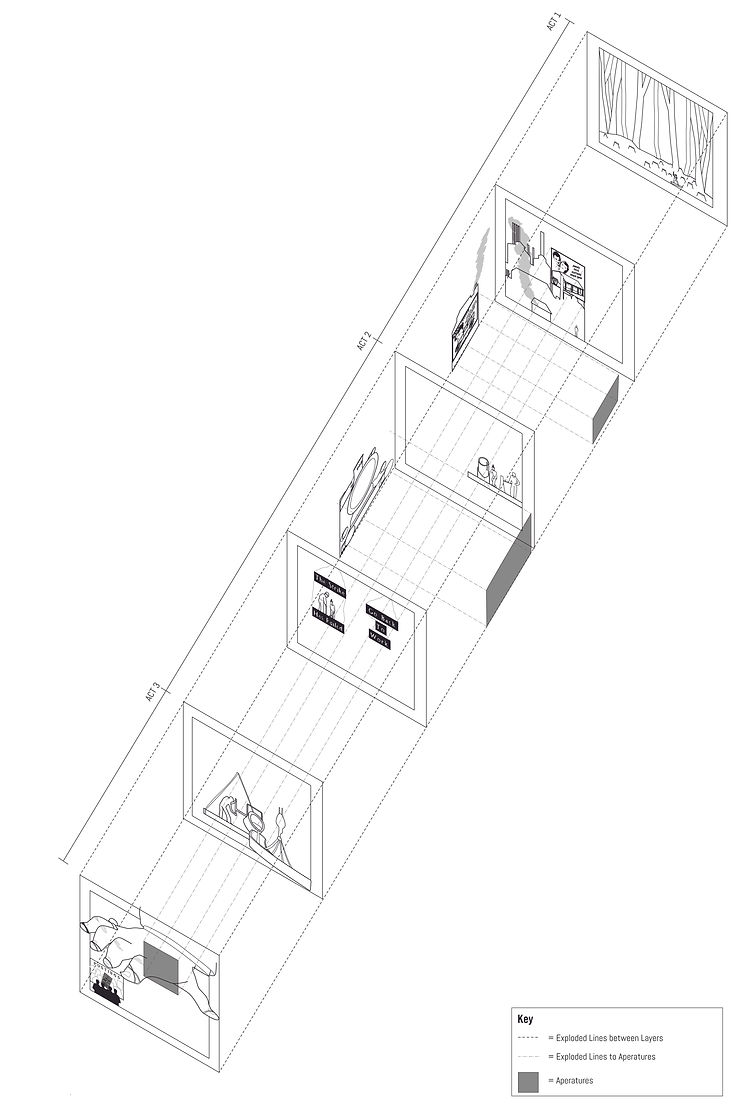%20copy.jpg)
Exploded Axonometric of Layers
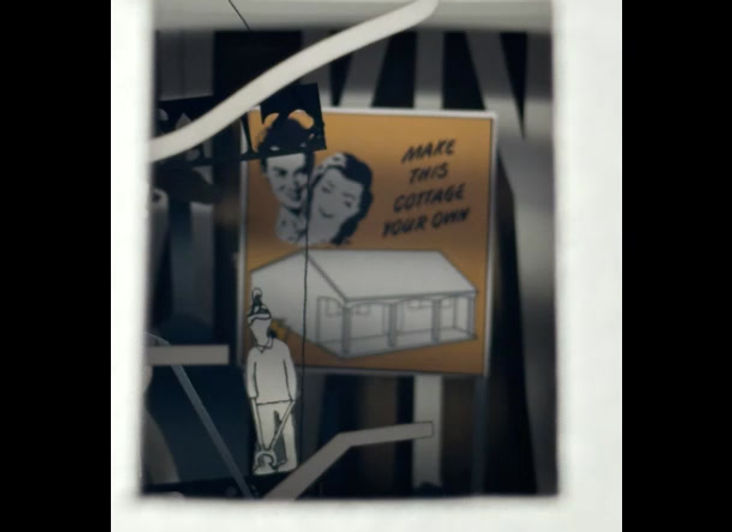
The scene begins in 1928, when the steel industry was strengthening in Pittsburgh and the boy and his father began to work in the factory together. Finally when the series ends it is in the mid to late 1930s, before children were banned at a federal level from factory work in 1938, but he is an adult at this point.
Script:
Deceptive Apertures:
One aperture shows the housing advertisement made by the Pittsburgh Steel Company, the next shows a car advertisement made by the Carnegie Steel Company. Without any context these companies seem like positive social forces but this advertising was misleading at the time and gave people a false sense of hope that they would be able to advance much more economically than was possible.
The next apertures show only the 765 Steam Engine, a train made in Pittsburgh. This image alone gives a false sense of the industry by only showing the successes without contextualizing the work culture that was created in order for such achievements to be possible.
The anti-child labor propaganda sign is displayed to signify this mentality was normalized and pushed by industry in Pittsburgh at the time. The cropping and lack of contextualization of these works contributes to the technology of propaganda and its ability to manipulate public perception through an omission or removal of relevant information.
Aperture of Truth:
Act 1
This story begins in the once dense forests of Pittsburgh and follows a factory worker who began working for big industry through an initial more removed role of forest clearing. Here he is connected to greater industry but he maintains his autonomy working on his own within the confines of nature and not the built environment.
He appears most human and detailed in his articulation; dwarfed by the natural conditions of the environment and not by industry.
Then as industries grow and expand he is enticed by the opportunities and advancements advertised by the steel industry. Notably in this scene it is two billboards advertising buying a car and buying a house that convince him to begin to work in a factory. He is lured into industry by a false sense of opportunity.
Act 2
He is now operating machinery but still in control of himself and not physically tethered to the industry. He also is influenced to bring his own child to work as well, in order to further contribute to the industrialist system and make a greater profit. He is slowly losing his initially detailed articulation as he works in the industry for longer.
His child is still working in the mills and is being berated by a foreman to work more and his father does not intervene. The words projected through the factory that are being directed to the young boy by the foreman are taken from a newspaper article after the Homestead Strike. The final result was a major defeat for the union strikers and a setback for their efforts to unionize steelworkers. The dispute occurred between the Amalgamated Association of Iron and Steel Workers and the Carnegie Steel Company.
Act 3
Then the transformed worker becomes only a form. The original figure is gone, signifying that he has been fully lost to the system due to overwork.
The final frame reveals the invisible hand that has been controlling the system the entire time and is now fully in control of the once autonomous factory worker. The new faceless workers look at the posting board with the anti-child labor sign posted on it, and among the faceless workers is the once young boy who has now grown into the system.
This ending is meant to be ambiguous as the sign means an opportunity for hope through resistance, but it is also indicative of the harsh conditions and culture that existed in order for such a resistance to be necessary. The hand is also not encompassing this part of the scene, yet reaching to grasp for it. This symbolizes the desire for big industry to control the messaging of factories, but being unable to do so. The false apertures all also ignore the invisible hand through cropping it out of frame. This is to emphasize that the pro-industry propaganda at the time ignored the fact that these purely capitalist systems were only working for the small set of people able to control them.

This drawing uncovers the peep show in terms of the systems existing within the layers. The drawing also provides the name of the figure as well as its role within the peep show.
%20copy.jpg)
The collection of images is organized by corresponding layer as with the previous drawing. The images define and contextualize the references used within the peep show.
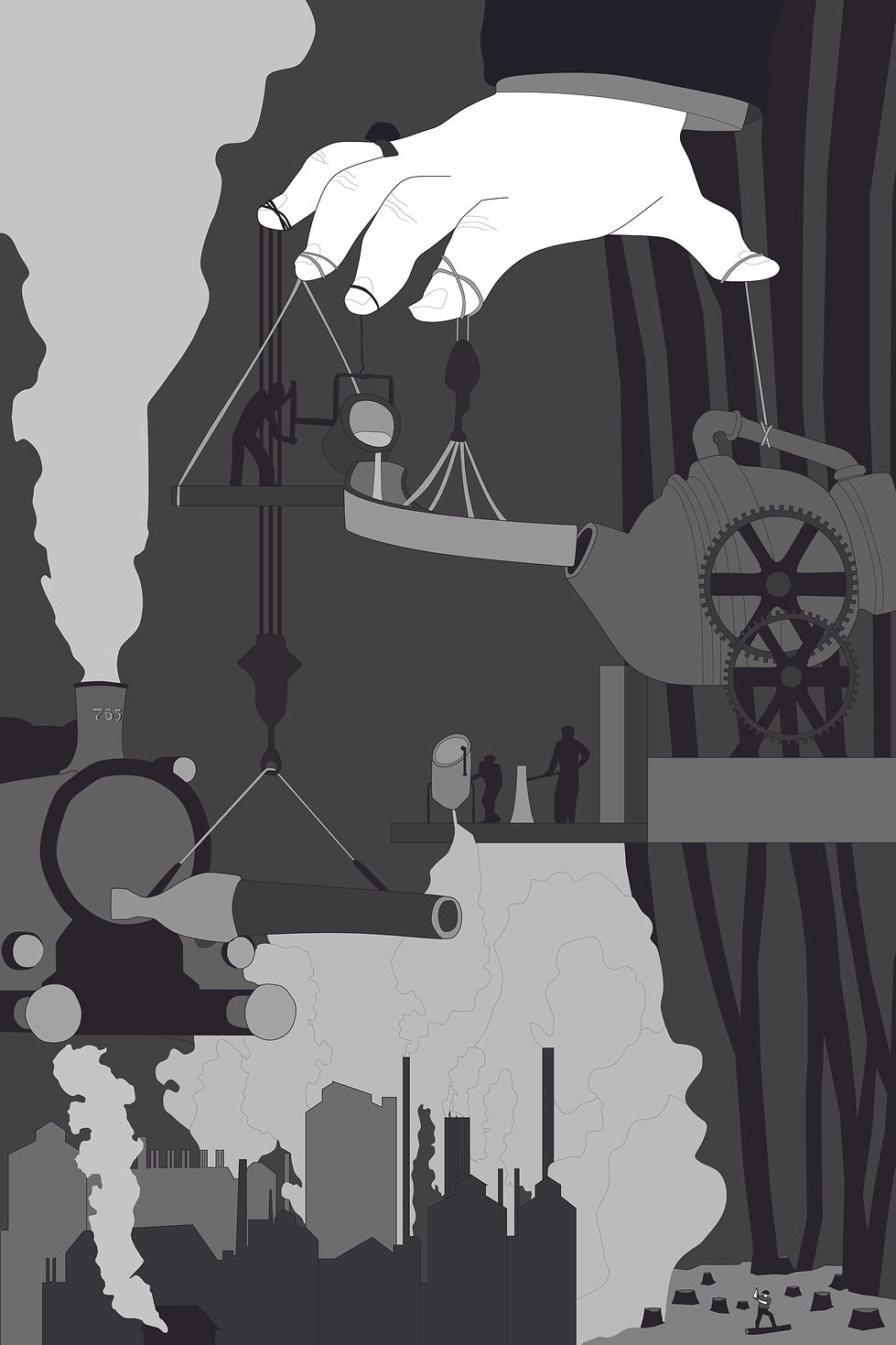

City as Propaganda:
Steeland
Steeland is a propagandized view of the city of Pittsburgh. The amusement park plays into industrial era propaganda that glorified industry labor and ignored the human perspective. The project takes a particular focus on attempting to entice individuals from other countries to move to Steeland to become a part of industry. The park specifically focuses on immigration from Serbo-Croatian territories, hence the use of language. This is reflective of the propaganda at the time in Pittsburgh that attempted to do the same. The project also attempts to commentate on American consumerism and the commodification and trivialization of labor and the working class.

Mural Key
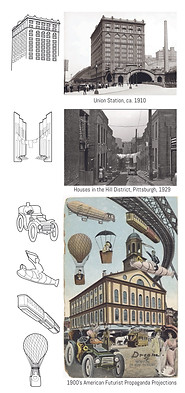

Amusement Park Informational Pamphlet
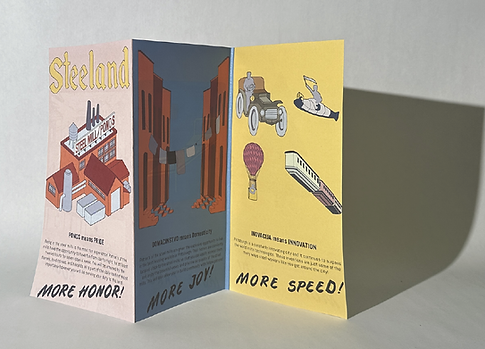
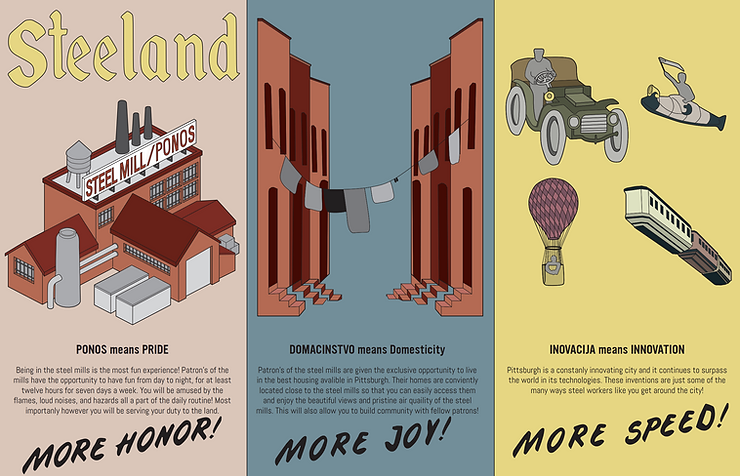
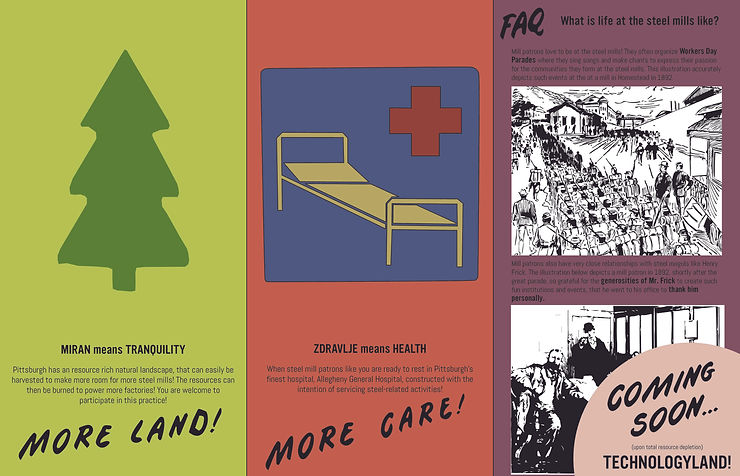%20copy.jpg)
Steeland Souvenir
This souvenir contributes to the idea of commodification and the selling of a lifestyle. The souvenir acts as a critique of U.S. marketing propaganda that reduces individuals to traditional archetypes.








